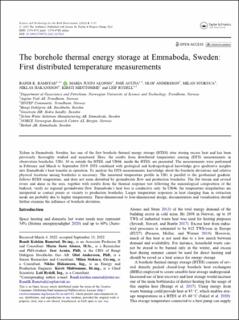| dc.contributor.author | Ramstad, Randi Kalskin | |
| dc.contributor.author | Justo Alonso, Maria | |
| dc.contributor.author | Acuna, José | |
| dc.contributor.author | Andersson, Olof | |
| dc.contributor.author | Stokuca, Milan | |
| dc.contributor.author | Håkansson, Niklas | |
| dc.contributor.author | Midttømme, Kirsti | |
| dc.contributor.author | Rydell, Leif | |
| dc.date.accessioned | 2023-01-30T13:54:40Z | |
| dc.date.available | 2023-01-30T13:54:40Z | |
| dc.date.created | 2022-10-17T17:54:42Z | |
| dc.date.issued | 2022 | |
| dc.identifier.citation | Science and Technology for the Built Environment. 2022, . | en_US |
| dc.identifier.issn | 2374-4731 | |
| dc.identifier.uri | https://hdl.handle.net/11250/3047197 | |
| dc.description.abstract | Xylem in Emmaboda, Sweden, has one of the first borehole thermal energy storage (BTES) sites storing excess heat and has been previously thoroughly studied and monitored. Here, the results from distributed temperature sensing (DTS) measurements in observation boreholes, UB1, 10 m outside the BTES, and UB46, inside the BTES, are presented. The measurements were performed in February and March to September 2019. DTS combined with geological and hydrogeological knowledge give qualitative insights into Emmaboda’s heat transfer in operation. To analyze the DTS measurements, knowledge about the borehole deviations and relative physical locations among boreholes is necessary. The measured temperature profile in UB1 is parallel to the geothermal gradient, follows BTES temperature, and does not seem disturbed by groundwater flow and production boreholes. The flat terrain and several rivers and dams in the area, together with results from the thermal response test following the mineralogical composition of the bedrock, verify no regional groundwater flow. Emmaboda’s heat loss is conductive only. In UB46, the temperature irregularities are interpreted as contact points or vicinity to production boreholes. Larger temperature responses in heat charging than in extraction mode are probably due to higher temperatures. Three-dimensional to four-dimensional design, documentation and visualization should further examine the influence of borehole deviation. | en_US |
| dc.language.iso | eng | en_US |
| dc.publisher | Taylor & Francis | en_US |
| dc.rights | Attribution-NonCommercial-NoDerivatives 4.0 Internasjonal | * |
| dc.rights.uri | http://creativecommons.org/licenses/by-nc-nd/4.0/deed.no | * |
| dc.title | The borehole thermal energy storage at Emmaboda, Sweden: First distributed temperature measurements | en_US |
| dc.title.alternative | The borehole thermal energy storage at Emmaboda, Sweden: First distributed temperature measurements | en_US |
| dc.type | Peer reviewed | en_US |
| dc.type | Journal article | en_US |
| dc.description.version | publishedVersion | en_US |
| dc.source.pagenumber | 17 | en_US |
| dc.source.journal | Science and Technology for the Built Environment | en_US |
| dc.identifier.doi | 10.1080/23744731.2022.2127621 | |
| dc.identifier.cristin | 2062197 | |
| dc.relation.project | Norges forskningsråd: 281000 | en_US |
| cristin.ispublished | true | |
| cristin.fulltext | original | |
| cristin.qualitycode | 1 | |

